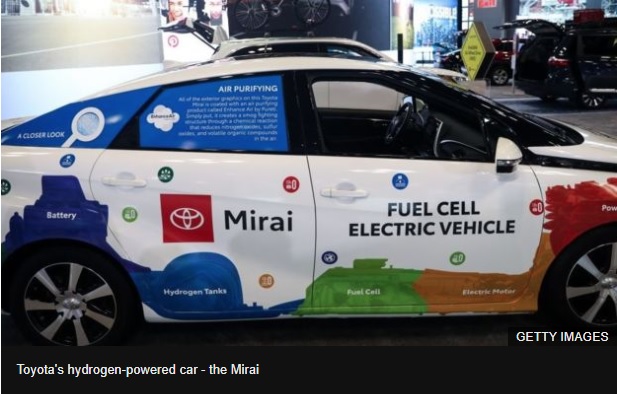
It's a question I couldn't avoid as I drove across central England in a borrowed car powered by a hydrogen fuel cell.
The Hyundai ix35 was fast, eerily quiet - they've installed a little electronic jingle so you can tell when you've switched it on - and there was a reassuring 230 miles (370 km) left on the clock.
And best of all, I drove with the smug knowledge that when a vehicle is powered by hydrogen, the only exhaust product is water.
Quite a difference from my own 13-year-old, one-litre petrol engine: noisy, slow and undeniably dirty.
So why, I wondered, is this clean, green technology lagging far behind the hybrid and all-electric sectors?
The relatively small hydrogen market is dominated by the Asian giants: Toyota, Honda and Hyundai.
In early October in Tokyo amid great razzmatazz, Toyota unveiled its latest fuel cell Mirai saloon, which it hopes to launch in late 2020.
European brands including BMW and Audi are also fine-tuning their own hydrogen vehicles.
But this is a sector in which the upstart start-up can claim a modest place too.
Outside Llandrindod Wells, a small market town in central Wales, Riversimple aims to lease, not sell, its futuristic hydrogen fuel cell vehicles to a strictly local market.
They have just two cars on the road so far, with Numbers 3 and 4 under construction in Riversimple's meticulously clean production facility.
"The car's called the Rasa - as in tabula rasa, or clean slate," says the company's founder and chief executive, Hugo Spowers.
"We're using fuel cells off the shelf: ours was made for fork-lifts for Walmart warehouses."
The Rasa will do a tidy 60mph (100km/h) and has a range of around 300 miles (480km) on a single 1.5 kg hydrogen tank.
"In purely calorific terms," Spowers concludes, "our car is doing the equivalent of 250 miles to the gallon."
That sounds impressive - so how do hydrogen powered cars work?
At the heart of the car is a fuel cell, where hydrogen and oxygen are combined to generate an electric current, and the only by-product is water. There are no moving parts in the fuel cell, so they are more efficient and reliable than a conventional combustion engine.
While the cars themselves do not generate any gases that contribute to global warming, the process of making hydrogen requires energy - often from fossil fuel sources. So hydrogen's green credentials are under question.
And then there is the question of safety. Hydrogen is a notoriously explosive gas.
That's why manufacturers disclose plenty of reassuring detail on their websites.
The Toyota Mirai, for example, boasts triple-layer hydrogen tanks capable, the company says, of absorbing five times as much crash energy as a steel petrol tank.
The twin hydrogen tanks in the Honda Clarity are similarly robust featuring layers of aluminium and carbon fibre and designed to resist both extreme pressure and extreme heat.
Still, not everyone is convinced.
EuroTunnel does not allow "vehicles powered by any flammable gasses", including hydrogen, to use the link between the UK and France.
The Riversimple business model - a three-year fixed price lease aimed at short-distance local drivers - is designed to negate the biggest problem affecting hydrogen cars: range anxiety.
With just 17 pumps across Britain, refuelling is a challenge, so the industry is stuck.
The public won't commit if they can't guarantee a refill wherever they need to drive, but hydrogen production companies are reluctant to install expensive pumps unless there's likely to be a consistent take-up.

